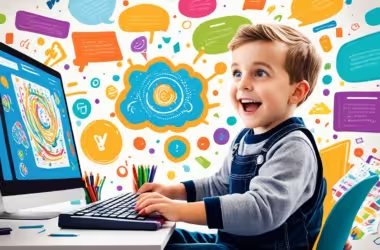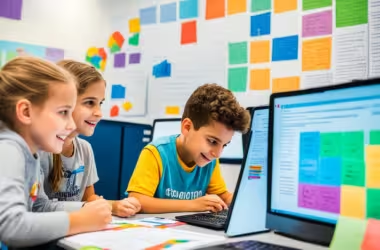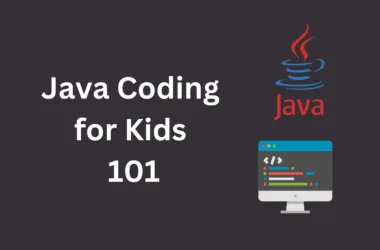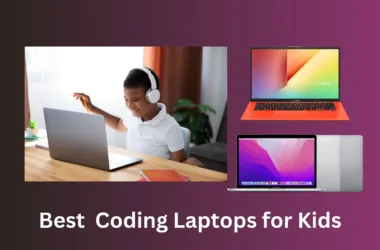Have you ever thought about how coding teaches kids to be tomorrow’s innovators? Today’s world changes fast, especially with technology. It’s key to teach kids about computational thinking. This helps them understand tech and solve real issues.
Adding coding to school curriculums gives kids important problem-solving skills. It also grows their creativity and thinking skills. Our goal is to help kids become tech creators, not just users. Let’s explore how coding sparks curiosity and changes how kids see the world.
Understanding Computational Thinking
Understanding computational thinking is key in our tech-focused world. It’s not just about coding. It’s a way to solve complex problems in all areas of life. Students learn to break down big issues, spot patterns, and create step-by-step solutions.
Definition of Computational Thinking
Computational thinking involves Decomposition, Pattern Recognition, Abstraction, and Algorithm Design. These skills help even young learners tackle difficult concepts. For instance, when kids plan their mornings, they’re learning to organize, prioritize, and manage their time effectively.
Importance in Today’s Tech-Driven World
The value of computational thinking is huge in our digital age. With the growth of automation and AI, tech skills are more vital than ever. Employers want people who can code and understand algorithms. But it’s not just for jobs. This thinking boosts creativity and problem solving. And it’s tied to brain development too.
Why Teach Kids Coding?
Coding offers many benefits for kids, like better problem-solving skills and creativity. It teaches them to think logically and be innovative. With coding, they get important technical skills.
Benefits for Problem-Solving Skills
Coding helps kids improve their problem-solving skills. They learn to approach problems in an organized way. As they write and fix code, they practice finding solutions step by step.
- Children learn to break down complex issues into manageable parts.
- They become familiar with algorithmic thinking, a key component in many subjects.
- Coding activities promote persistence, as coding often requires overcoming obstacles and failures.
Enhancing Creativity and Innovation
Kids’ creativity flourishes with coding. They are encouraged to try out their ideas, leading to new solutions. By working on coding projects, they can show their creativity and think of new ideas.
- Projects such as game development allow children to visualize their ideas.
- Programming exercises stimulate imaginative problem-solving approaches.
- Children can collaborate with peers, enhancing their creative processes and teamwork skills.
Key Principles of Computer Science Education
Computer science is key in today’s learning world. It gives students important skills and encourages creativity and critical thinking. By using these principles in all subjects, students do better in school and get excited about learning forever.
Integration of CS with Other Subjects
Mixing computer science with other areas like math and science is vital. It helps students use computer thinking in different situations. This way, students learn to:
- Break down complex problems into manageable parts.
- Recognize patterns and make connections between different disciplines.
- Develop algorithmic thinking and enhance problem-solving skills.
More places in the U.S. and around the world see the value of computer science in schools. England and Australia are ahead by making it a must in education. They are setting an example for others.
Empowering Students as Creators, Not Consumers
Computer science teaches students to make technology, not just use it. This change allows them to be active in the digital world. By learning to create, students get:
- A deeper understanding of technology and its applications.
- Confidence in using tools for creative expression.
- Innovative thinking that goes beyond usual learning.
It’s important to help students see themselves as future innovators. With a focus on computer thinking, they’re ready for big challenges. They learn skills that help in school and in careers in tech.
Coding for Kids Computational Thinking
Teaching kids to code is a stepping stone for vital programming skills. To make coding simple, we must break down complex ideas. These include decomposition, pattern recognition, abstraction, and algorithms. These elements are key for young minds to grasp coding. They also improve problem-solving abilities.
Building Blocks of Coding for Kids
Decomposition teaches kids to break big tasks into smaller parts. This makes solving problems easier. Pattern recognition helps kids find similarities in different problems, leading to creative solutions.
Abstraction allows kids to ignore unimportant details and focus on what’s important. Algorithms give them a step-by-step process to solve problems, which boosts logical thinking.
Engaging Activities to Foster Critical Thinking
Coding activities for kids boost their critical thinking. Designing games or solving puzzles makes them use computational thinking. These activities spark curiosity and creativity.
Creating algorithms not only helps remember what they’ve learned. It also builds key skills for their future in school and work.
Effective Teaching Methods for Integrating CS
Introducing new ways to teach CS makes learning more exciting. Using project-based learning and modeling techniques can really help. Students learn better by solving actual problems, working together, and thinking critically.
Project-Based Learning Approaches
Project-based learning is key for teaching computer science effectively. It lets students solve problems from the real world together. They learn more deeply and gain vital skills like communication and teamwork. Support from both teachers and parents boosts their interest in computer science. By giving students specific roles, teachers can help those with learning disabilities succeed and feel included.
Utilizing Modeling and Simulation Technologies
Modeling and simulation bring an interactive part to learning. Students get to understand scientific ideas and social concepts by using simulations. This way of learning helps with thinking needed in many areas, not just computer science. Using these tools, students can put what they’ve learned into action. This improves their ability to solve problems and encourages them to keep growing.
Resources for Teaching Computational Thinking
Finding the right tools is key to teaching computational thinking well. A mix of websites and books can improve lessons and catch students’ interest. They provide top-notch teaching aids that help explain coding and computational ideas better.
Websites and Online Platforms
Many websites offer great resources for teaching computational thinking. Code.org has lessons, videos, and fun activities for coding. Hopscotch, an app just for K-12 students, lets them build and play games safely. Google for Education has a course called “Exploring Computational Thinking” that improves these skills.
Platforms like Scratch let kids make animations and games with easy drag-and-drop actions. This makes learning to code fun and simple.
Books and Curriculum Guides
Books on computational thinking and coding are key for teachers. They provide step-by-step guides for teaching these concepts. Focusing on algorithms, breaking down problems, and finding patterns is vital. These books make learning engaging and enjoyable.
Works that combine STEAM principles with active learning prepare students for tech careers. Computer Science Unplugged includes exciting activities for learning about algorithms. The Wolfram Computational Knowledge Engine ties computational thinking to different subjects, making class discussions richer.
The Role of Teachers in CS Education
Teachers play a vital role in laying a strong foundation for computer science (CS) education. They create learning spaces where everyone feels welcome. This encourages students to explore, and work together.
By using different ways to teach, they make sure every student feels important. This helps everyone on their learning path.
Creating an Inclusive Learning Environment
Making sure education is inclusive is key for coding. Teachers need to understand and meet the varied learning needs of students. By doing this, the educational journey gets better and encourages team spirit.
- Emphasizing collaboration: Group activities encourage students to work together. This boosts social skills and mutual learning.
- Adapting instruction: Using tools that blend block-based with text-based coding supports different learning levels and builds confidence.
- Highlighting real-world connections: Teachers can show how coding links to life. This makes computer science exciting and relevant.
- Encouraging critical thinking: Through problem-solving activities, students gain valuable skills. These skills are useful in many areas.
With these strategies, teachers’ roles in CS grow in importance. They ready students for coding challenges and fuel a lasting passion for the subject. This makes education for all a key part of future breakthroughs.
Encouraging a Curious Mindset
Fostering curiosity in students is key to loving inquiry-based learning. Teachers can create a space where exploration is encouraged. This leads to students being more involved and asking more questions. Such an environment not only boosts their learning experience but also preps them for future challenges.
Strategies to Foster Inquiry-Based Learning
Using effective strategies is vital for promoting inquiry-based learning. Here are some ways to spark student curiosity:
- Challenge-Based Learning: Introduce real-world issues and push students to think up and craft solutions using technology.
- Hands-On Activities: Get students involved in coding projects that push them to think critically and creatively, making learning a hands-on experience.
- Open-Ended Questions: Ask questions that start conversations, leading students to explore different views and solutions.
- Collaborative Learning: Support group projects where students collaborate, building their ability to communicate and work as a team.
- Reflection and Feedback: Motivate students to think about their learning journeys and give helpful feedback to each other, creating a supportive classroom atmosphere.
With these engagement strategies, teachers can inspire students to chase their questions and interests. This active stance in learning helps grow a mindset equipped for tackling complex problems with resilience.
Real-World Applications of Computational Thinking
Computational thinking is more than just theory. It shows up in real problems we need to solve. When kids get hands-on, they’re not just learning. They’re using what they know to face challenges in the world. These examples show how students deal with issues locally and globally. It helps them see how problem-solving works every day.
Case Studies: Kids Solving Real Problems
Many case studies show how important computational thinking is for young people. Let’s look at some big moments:
- Environmental Projects: Kids joined in cleaning their communities. They used their planning and thinking skills to find the best ways to help nature.
- STEM Challenges: In engineering projects, students built designs for buildings that could survive earthquakes. They combined science and creativity in their work.
- Data Analysis in Math: Middle school students worked on a math project where they looked at data with scatter plots. They got better at algebra while solving real data issues.
- Social Studies Integration: Decoding messages related to the German Enigma machine was a project for some. It helped them learn history and improve their computational thinking.
Kids use computational thinking all the time. It might be when they’re figuring out puzzles, doing math homework, or planning their day. These experiences in using computational thinking are key. They inspire new ideas and independent thinking. This prepares them for careers where they’ll need these skills.
Success Stories in Coding Education
Coding education success stories are truly inspiring. They show how effective coding programs change lives. Schools nationwide are adopting new coding classes. This gives students a chance to get better at tech skills. They don’t just learn to code. They also get better at thinking creatively and solving problems.
Examples of Successful Programs
Many programs have shown great success in coding education. For example, Code.org is doing amazing work. They make computer science easy for kids to get into. Kids learn fun coding languages like Scratch and JavaScript. Then there’s Girls Who Code. They help close the gender gap in tech. They create a place where girls can excel and be innovative. These programs prove that coding education can spark a love for technology. They prepare kids for the tech jobs of tomorrow.
Student Testimonials
What students say about coding classes matters a lot. They talk about how much fun they have learning to code. Completing projects gives them a real sense of achievement. They don’t just get better at coding. They also become more confident.
Working together on projects teaches them to communicate better. It also encourages them to be creative and resilient. These stories show the lasting impact of coding education. It’s more than just learning to code. It’s about gaining skills that will help throughout life.
Conclusion
Today’s world is changing fast, making coding vital for kids. It’s not just a trend. It’s a must-have skill. Teaching coding helps students think creatively and solve problems. These are key skills for real-life success.
Coding makes children more adaptable and innovative. They learn to simplify big problems. This skill bridges the tech gap and preps them for future jobs like in AI or data science.
We need to make coding a big part of learning. It prepares our kids for a tech-filled future. Educators should make coding a key part of school. It’s time to act and bring coding into classrooms.






